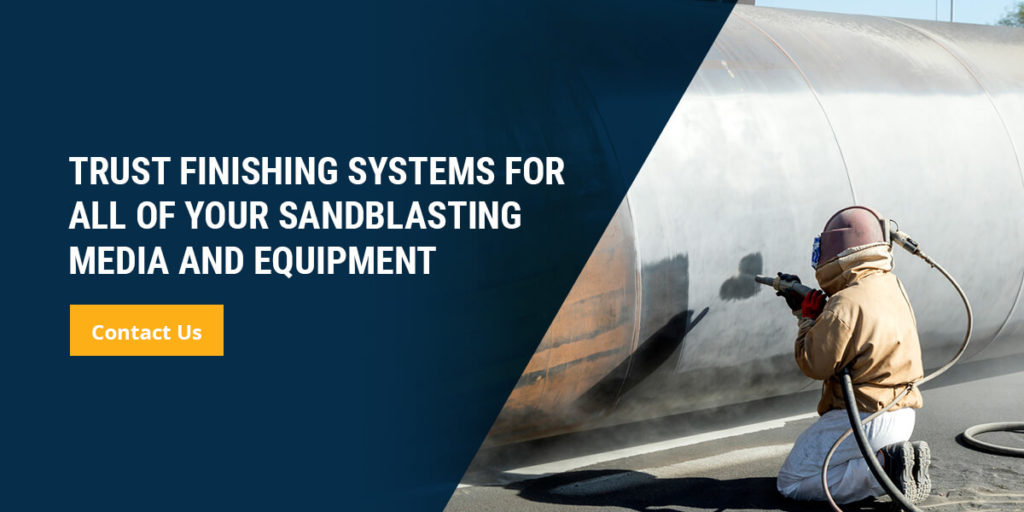Sandblasting Media
Updated: November 20, 2023Sandblasting is an extremely useful procedure in a broad array of applications and industries. Whether a material needs to undergo cleaning, deburring, prepping for powder-coating, de-rusting, shot-peening or just paint removal, the sandblasting process is right for the job.
These devices are useful in the auto industry, in ship and rail yards and in a range of industrial applications. Your intended application may require certain degrees of skill and safety training to effectively operate the sandblaster.

When a surface has a coating of grease, paint or another undesired veneer, a sandblaster can completely remove the residue and restore the item to its original condition. When machining leaves sharp burrs on an object, sandblasters can smooth it until it is safe to handle. Shot-peening is another useful application in which a metal undergoes a barrage of small but powerful impacts — think of what a ball-peen hammer does — in order to make it more malleable. This gives the surface of the metal a compressive, plastic quality that is less likely to develop tiny micro-fractures.
Let’s look at how sandblasters work as well as the different sandblasting media types.
How Sandblasting Media Works
What is sandblasting and how does it work?
A sandblaster uses pressurized air to hurtle a beam of tiny projectiles, which range from walnut shells to glass beads and tiny rock particulates.
It all starts with two components: the blast pot and the pressurized air intake. The blast pot is a large container that holds the blast media, whether it is glass beads, corn cob, steel shot, plastic or other abrasive blasting media. It funnels the media downward through a set of valves that allow you to control the amount entering the system.

This media then joins the pressurized air as it zips into the chamber. Note that air pressure is entirely responsible for the process of sandblasting — it is the force that whips the media around. Adjusting it in turn adjusts the speed of the particles. Sandblaster air requirements are quite strict as a result — you need a remote-control system for both precision and safety.
The air and media travel through the blast hose and out of a nozzle. At this point, they are inside the sandblasting chamber, whether that is a small compartment or an entire room, and usually come out the nozzle of a handheld gun. The particles travel at high velocities and impact the object, stripping it of whatever is on its surface. Depending on the size, texture and density of the particles, they will also leave tiny divots in the material. These divots allow future coatings to adhere to the object’s surface.
What goes in must come out. For the chamber to avoid turning into a pressure bomb, air must escape at the same rate it enters. This is where an abrasive trap comes in handy. At the point where air escapes the chamber, a trap is in place to catch the abrasive media — otherwise it would fly out of the chamber as well.
These two basic components apply to both cabinet and portable sandblaster models.
Benefits of Sandblasting
While the blast media you use will vary depending on your specific surface and project needs, they all offer benefits such as:
- Cleans and smooths objects: Many industries include sandblasting in the finishing process because it cleans and smooths surfaces simultaneously. Sandblasting makes cleaning surfaces such as metal easier and can effectively remove oil, rust and other harmful contaminants.
- Quick and efficient: Since only one person is needed to operate the sandblasting machine, it is a quick and efficient way to complete projects without a high labor cost. You can also begin using it fairly quickly after setup since there is no need for intensive preparations that use harsh chemicals or require large amounts of scrubbing. Cleaning up after completing a sandblasting job is simple, as there is little waste except sandblasting grit.
- Cost-effective: Using a sandblaster is also extremely cost-effective as you will not have any additional startup costs after setting up your booth and buying the protective materials. Many types of abrasive media are recyclable, allowing you to save even more money.
- Safe: Sandblasting is environmentally friendly and nontoxic. You can quickly dispose of the material without causing harm to the surrounding ecosystem.
Trust Finishing Systems for All of Your Sandblasting Media and Equipment
Finishing Systems is your one-stop shop for all of your sandblasting needs. We have been industry leaders since 1972 and a partner for many top companies such as Caterpillar, Harley Davidson and Mack Trucks.
Our custom solutions can cover all aspects of the sandblasting process from preparation to curing. We have earned industry recognition due to our turnkey finishing solutions and offer a sandblasting material guide to help any business of any size find the appropriate resources. To learn more about the many benefits of working with us, we invite you to contact us online today!

